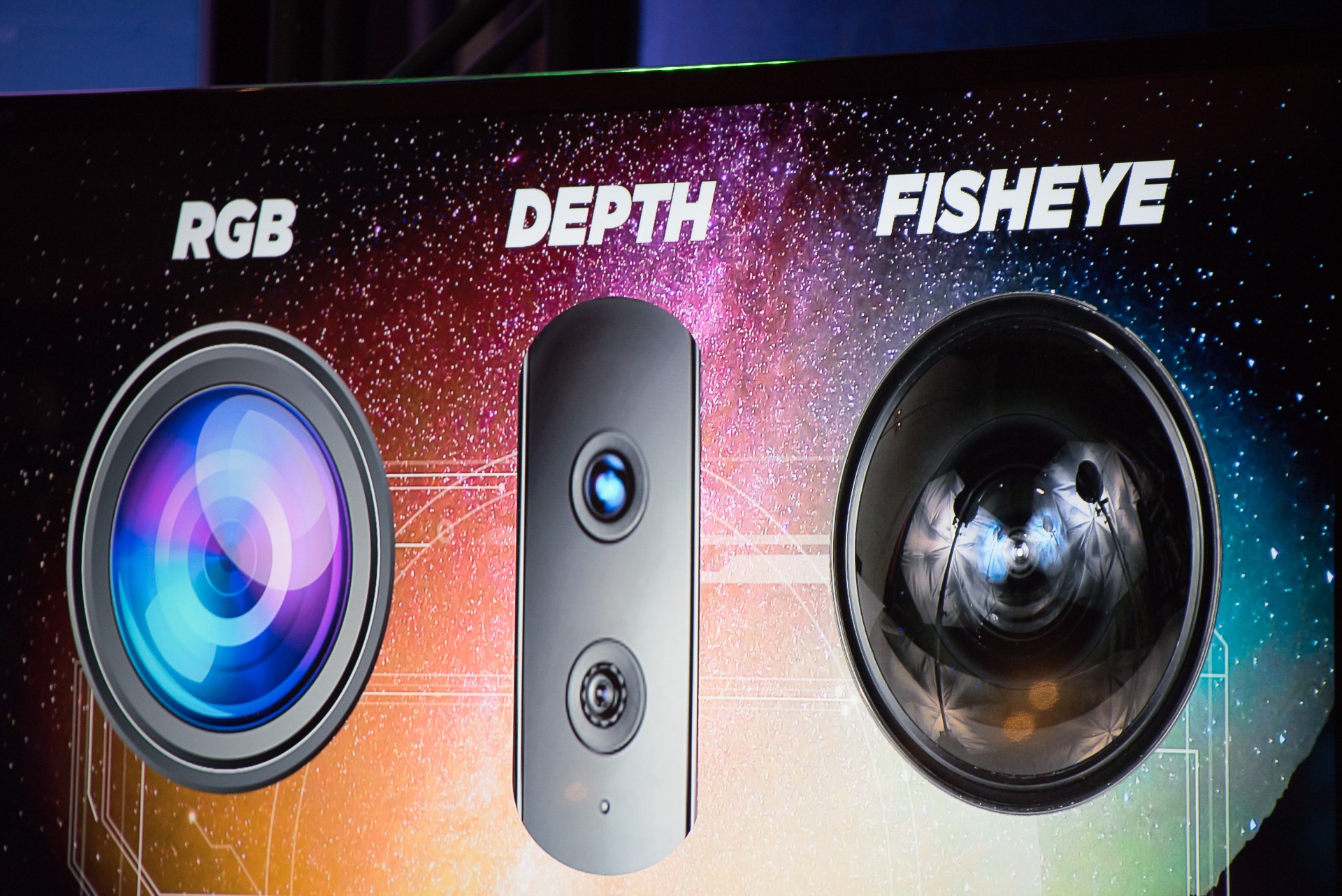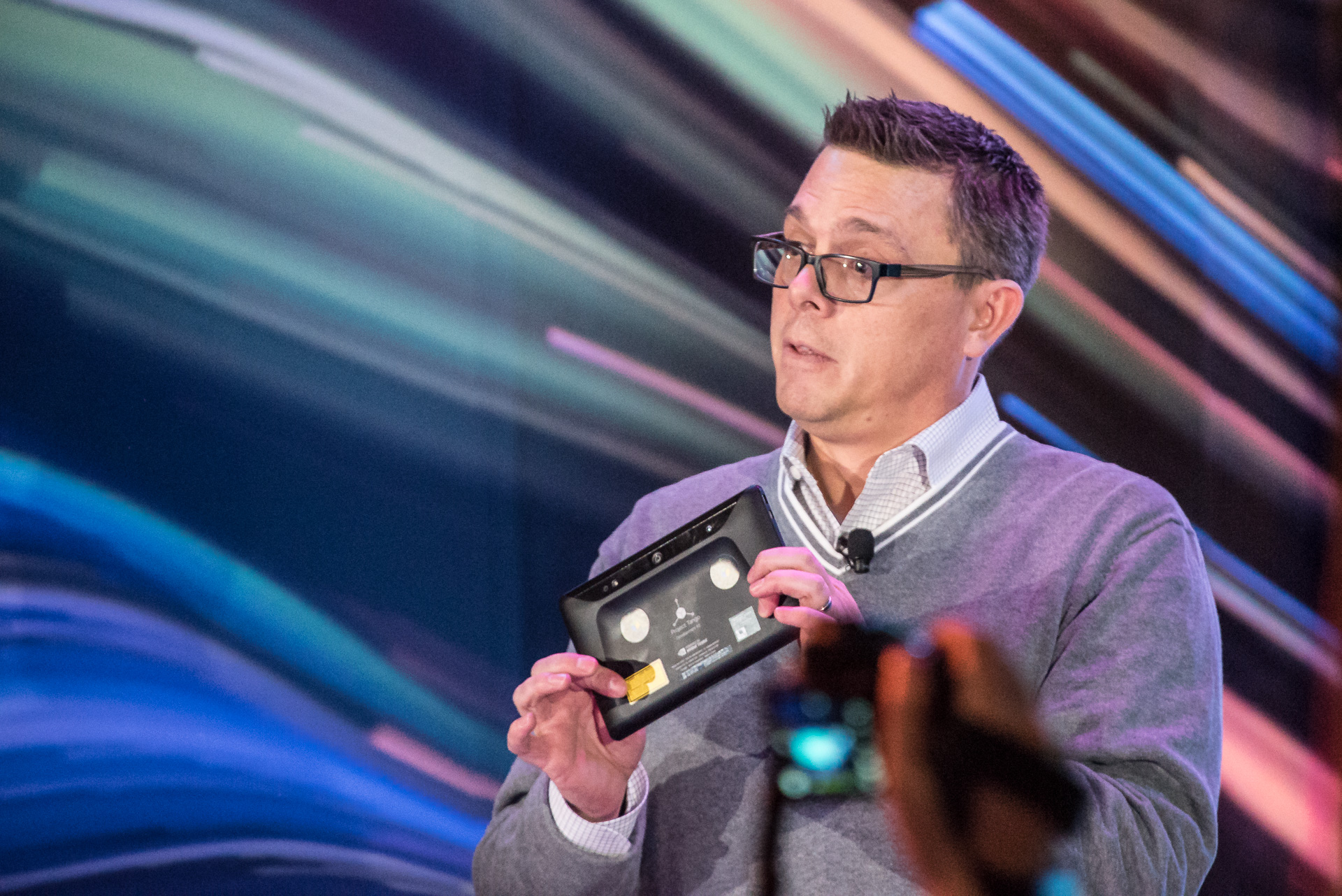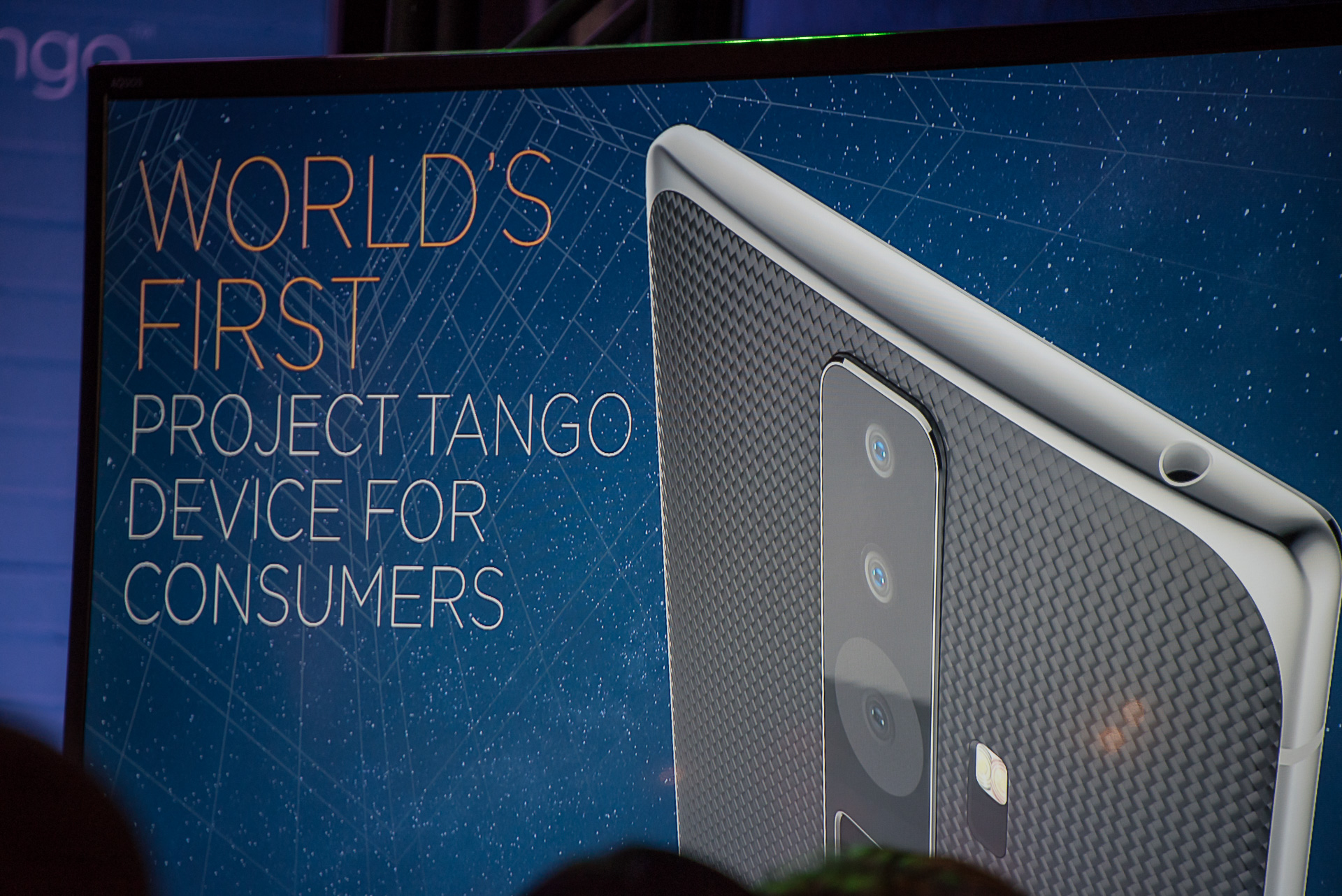Lenovo, Intel Have Duelling Project Tango Smartphones
At an evening event at CES 2016 in Las Vegas, Lenovo showcased its Project Tango smartphone, but the whole presentation seemed familiar. That’s because we’ve already seen something strikingly similar to this tech at work on shipping devices, and also because Intel has a Project Tango phone, too.
Backing up a bit: Project Tango was a Google ATAP project that eventually migrated from those secretive labs to public demos and now to actual products. Simply put, the technology uses a depth-sensing camera on a mobile device to map any space in (basically) real time. It can then superimpose images and such on top of the real world, which you can see by looking at the device’s display.
Project Tango and Intel RealSense were virtually made for each other, a happy marriage of hardware and software.
Lenovo’s Enthusiasm And Nervousness
At the event, in a crowded restaurant in the Venetian, a Lenovo rep took the stage to show off what the company’s mobile device could do. However, some of the demos we’ve seen before. For example, in one demonstration, you can use the depth camera to measure physical objects in space. We’ve already written about this RealSense capability, on the Dell Venue 8 7000 tablet. (We found issues with the accuracy consistency.)
The rest of the demos worked just fine -- he placed a virtual couch in a physical space, played with a virtual kitten that could sense the physical furniture and clamber on it, and played two-person virtual Jenga -- but none were particularly compelling. Mostly, it seemed like fun and games.
One key demo, though, showed how you can see a map overlaid onto the real world to give to give you walking directions through a building. You look at the phone’s display and use the rear camera to give you what amounts to a pass-through view of the real world. Then, through the display, you can see the directions superimposed on top (complete with arrows that point where to go) as you, for example, run frantically through a casino or hotel trying to find your next CES meeting.
Given the sheer volume of new products that Lenovo announced at the show, it’s telling that the company held a special event to showcase this one device. However, the presenters themselves seemed less “enthusiastic” and more “nervous.”
Get Tom's Hardware's best news and in-depth reviews, straight to your inbox.
I presume this is because the Lenovo Project Tango phone either isn’t completed yet, or the people working on the project aren’t certain it’s going to work as advertised. (Or, worse, maybe they aren’t convinced of its use case.)
There was a lot of “we’re going to” language as opposed to “we have” language. We’re going to create this ecosystem of apps. We’re going to put a Qualcomm Snapdragon processor in it. It’s going to cost under $500. That sort of thing.
Or, perhaps I’m just being overly skeptical and seeing things that aren’t there.
However, there was a similar lack of enthusiasm from Intel about its own Project Tango smartphone. We received no press release mentioning that the dev kits were coming, and the booth (if you can call it that) showing off the new wares was all but hidden away under some stairs. I actually found it by accident.
In any case, there are about to be at least two Project Tango smartphones hitting the market. Intel’s dev kit is shipping this quarter, and Lenovo promised to ship its finished product to consumers starting this summer.
The Design, And A “Fundamental Shift”
Lenovo has not yet shared full specifications for its Project Tango smartphone, but we believe this is because -- as Lenovo stated -- the design isn’t quite complete yet. (The images shown on slides from the stage even looked like renders, not pictures.) Presumably, the development team needs to nail down some of the details of the whole design before deciding on exactly how much RAM and onboard storage there will be. If the design is not yet final, that also means that it hasn’t gone through FCC certification, which means that Lenovo can’t announce anything about carrier support, either.
Lenovo did say that it reworked the PCB design for the smartphone form factor. For example, the team determined that users will most likely hold the phone in portrait mode, so they moved the camera to the upper third of the device. They also mentioned a “mechanical solution” to alleviate heat. We’d be surprised to see a fan in any smartphone, but regardless, it’s unclear what “mechanical solution” means.
We know that the smartphone will have a Qualcomm Snapdragon chip, that it will be under 6.5 inches, and that it will cost under $500. (Insert $499.99 joke here.) The price is key here, and it reflects Lenovo’s stated desire for the Project Tango phone to be a mainstream, not a niche, device. Five hundred bucks is by no means cheap, but it’s nowhere near the price tags of the current crop of flagship smartphones (which can reach as high as $1,000, depending on configuration.)
Further down that line of thinking, Lenovo said that it sees the Project Tango technology as a harbinger of a fundamental shift in smartphones. An example they gave from the stage is GPS; time was, it was a special feature, but now you can’t buy a smartphone without it. In the same way, Lenovo hopes that the features and capabilities Project Tango unlocks will become almost a given on smartphones, and that’s good to hear. I can’t say that I think Project Tango will be world-changing necessarily (from what I’ve observed so far), but I’d be lying if I said I don’t want it on my next smartphone.
Availability
Although we don’t have details on supported networks, we can safely assume that it will at least support GSM, because the device is launching globally. It is also coming to the U.S., which is a welcome surprise; earlier this year, Lenovo wasn’t planning to release any smartphones into the U.S. market so as not to cannibalize sales of Motorola phones. (If you recall, Lenovo now owns Motorola.)
Whatever the support, the Lenovo Project Tango smartphone will be out this summer.
That App Ecosystem, Though
Like so many hardware developments, Project Tango is nothing without accompanying software and experiences. Kittens and Jenga aren't going to cut it for any user. To that end Lenovo is taking matters into its own hands by partnering with Project Tango on an App Incubator Program.
“In partnership with Lenovo, we’re inviting developers and studios from around the world to submit their ideas for gaming and utility apps created using Project Tango. We’ll pick the best ideas, provide support to help bring them to life, then feature the finished apps on select launch devices,” read the site’s homepage.
The call for proposals is open until February 15, 2016. We expect to hear about the winners at or just before Mobile World Congress, which takes place February 22-25 in Barcelona. At that time, we also expect more details about what’s under this smartphone’s hood.
Seth Colaner is the News Director for Tom's Hardware. Follow him on Twitter @SethColaner. Follow us on Facebook, Google+, RSS, Twitter and YouTube.
Seth Colaner previously served as News Director at Tom's Hardware. He covered technology news, focusing on keyboards, virtual reality, and wearables.
-
scolaner Reply17303909 said:Typo Alert:
"That App Ecosystem, Though"
Should be:
"Dat App Ecosystem, Doe"
Lol! I couldn't bring myself to take it all the way. ;) -
bit_user Reply
This is one of my favorite AR examples. I've been using that one for years, when trying to sell people on its potential.17302836 said:One key demo, though, showed how you can see a map overlaid onto the real world to give to give you walking directions through a building. You look at the phone’s display and use the rear camera to give you what amounts to a pass-through view of the real world. Then, through the display, you can see the directions superimposed on top (complete with arrows that point where to go) as you, for example, run frantically through a casino or hotel trying to find your next CES meeting.
But AR really belongs in a HMD, like Hololens. Having to hold up a phone or tablet is too obtrusive and ties up at least one hand. I think Tango tablets & phones are just a stepping stone, mostly for developers, and one that MS leapfrogged, completely.
In that sense, I think Lenovo should be nervous. Maybe this product will do alright, but I doubt even 10% of phones will ever have depth cameras. AR isn't going mainstream until it's much more seamless and powerful.
-
scolaner Reply17305824 said:
This is one of my favorite AR examples. I've been using that one for years, when trying to sell people on its potential.17302836 said:One key demo, though, showed how you can see a map overlaid onto the real world to give to give you walking directions through a building. You look at the phone’s display and use the rear camera to give you what amounts to a pass-through view of the real world. Then, through the display, you can see the directions superimposed on top (complete with arrows that point where to go) as you, for example, run frantically through a casino or hotel trying to find your next CES meeting.
But AR really belongs in a HMD, like Hololens. Having to hold up a phone or tablet is too obtrusive and ties up at least one hand. I think Tango tablets & phones are just a stepping stone, mostly for developers, and one that MS leapfrogged, completely.
In that sense, I think Lenovo should be nervous. Maybe this product will do alright, but I doubt even 10% of phones will ever have depth cameras. AR isn't going mainstream until it's much more seamless and powerful.
Fair point perhaps, but these phones are trying for "seamless" (let's leave "powerful" until we test them ;) ) I'm not yet convinced of the use case(s) for depth cameras on mobile devices, but then again, there may be a handful of devs who right now are thinking, "Finally, the hardware to support my awesome idea!"
I don't think this is any less obtrusive than anything else we use our mobile phones for...take maps, for example. We're currently looking at our phones and looking back up at roads or whatever. This is slightly better.
-
JeffKang This could be useful for a future iteration of the Pokémon Go augmented reality game that is coming out.Reply





